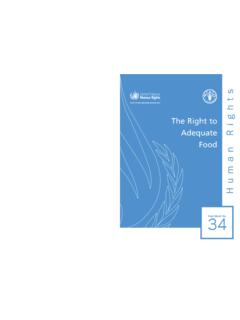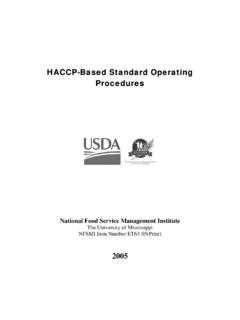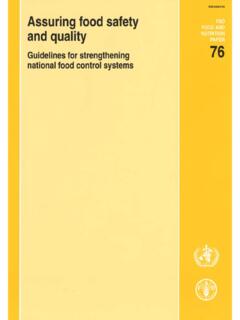Transcription of The future of food and agriculture – Trends and challenges
1 Trendsand challengesThe futureof food andagricultureISSN 2522-722X (online)ISSN 2522-7211 (print)1 The futureof food andagricultureTrendsand challengesFood and agriculture Organization of the United NationsRome, 2017 Citation: FAO. 2017. The future of food and agriculture Trends and challenges . Rome. The designations employed and the presentation of material in this information product do not imply the expression of any opinion whatsoever on the part of the food and agriculture Organization of the United Nations (FAO) concerning the legal or development status of any country, territory, city or area or of its authorities, or concerning the delimitation of its frontiers or boundaries. The mention of specific companies or products of manufacturers, whether or not these have been patented, does not imply that these have been endorsed or recommended by FAO in preference to others of a similar nature that are not mentioned.
2 ISBN 978-92-5-109551-5 FAO, 2017 FAO encourages the use, reproduction and dissemination of material in this information product. Except where otherwise indicated, material may be copied, downloaded and printed for private study, research and teaching purposes, or for use in non-commercial products or services, provided that appropriate acknowledgement of FAO as the source and copyright holder is given and that FAO s endorsement of users views, products or services is not implied in any way. All requests for translation and adaptation rights, and for resale and other commercial use rights should be made via or addressed to FAO information products are available on the FAO website ( ) and can be purchased through viAcknowledgements viiiAbbreviations ixExecutive summary xCAUSE FOR HOPE AND CONCERN 1 Trends 91 Population growth, urbanization and ageing 112 Global economic growth, investment.
3 Trade and food prices 173 Competition for natural resources 324 Climate change 395 Agricultural productivity and innovation 466 Transboundary pests and diseases 567 Conflicts, crises and natural disasters 628 Poverty, inequality and food insecurity 709 Nutrition and health 8010 Structural change and employment 8811 Migration and agriculture 9812 Changing food systems 10613 food losses and waste 11214 Governance for food and nutrition security 11815 Development finance 123 challenges 1331 Sustainably improving agricultural productivity to meet increasing demand 1362 Ensuring a sustainable natural resource base 1363 Addressing climate change and intensification of natural hazards 1374 Eradicating extreme poverty and reducing inequality 1385 Ending hunger and all forms of malnutrition 1396 Making food systems more efficient.
4 Inclusive and resilient 1407 Improving income earning opportunities in rural areas and addressing the root causes of migration 1418 Building resilience to protracted crises, disasters and conflicts 1429 Preventing transboundary and emerging agriculture and food system threats 14210 Addressing the need for coherent and effective national and international governance 143 ANNEX International frameworks of relevance to FAO s work and mandates 145 REFERENCES 151ivTflfi fi fi T fi fl fi fi Global population growth to 2100, by variant Population growth to 2100, by region (medium variant) Growth in global urban and rural populations to 2050 Urbanization Trends , by region Projections of GDP growth, by region Projections of per capita GDP growth, by region Growth in GDP to 2050, by region Growth of per capita GDP to 2050, by region Gross Fixed Capital Formation (GFCF), by region, 1990 2015 Investment rates, by country group and region, 1990 2015 Gross Fixed Capital Formation (GFCF) in agriculture , by country group and region, 1990 2015 Agricultural investment orientation ratio by region, 1990 2015 Agricultural net capital-output (value added)
5 Ratio, 1990 2015 Additional income and investment to eradicate hunger by 2030 Total and agricultural international trade volume, 1961 2015 Percentage of net food imports in domestic food supply in total calories FAO real food price index (RFPI) Agricultural and forest land use 1961 2013 Net forests conversion, by region, 1990 2015 Total annual freshwater withdrawals as a percentage of total annual available flow Trends and projections in land equipped for irrigation to 2050 Annual greenhouse gas emissions from agriculture , Forestry and Other Land Use (AFOLU) Annual greenhouse gas emissions from all sectors Projected changes in crop yields owing to climate change Average annual rate of change in crop yields Sources of growth in agricultural production, by country income group, 1961 2010 Averages of agricultural research intensity, by country income group Reported outbreaks of lumpy skin disease, per month, 2006 2015 Global spread of crop pests and pathogens, 1950 2000 Prevalence of undernourishment and protracted crises 637.
6 2 Climate-related disasters, 1980 2011 667. 3 Agricultural production losses after medium- to large-scale disasters in developing countries, by cause and region, 2003 2013 People below the poverty line (PPP) of US$ per day, 1990 2015 Per capita indicators of low- and middle-income countries relative to high-income countries, 1990 2015 GDP per capita projections in low- and middle-income countries as a share of high-income countries Undernourishment in a business-as-usual scenario, 2005 2050 Per capita calorie intake by source, 1961 2050 Per capita calorie intake in low- and middle-income countries compared to high-income countries Per capita protein intake by source, 1961 2050 Per capita protein intake in low- and middle-income countries compared to high-income countries Greenhouse gas emissions by diet type Sectoral contributions to aggregate GDP, by region, 1980 2010 Sectoral employment shares, by region, 1990 2010 Sectoral value added per worker.
7 By region Estimates of the population aged 15-24 years, 1950 2050 International migrant stock, by destination, 1970 2015 International migrants in destination countries, 1990 2015 Remittances to low- and middle-income countries compared with other financial inflows, 1990 2018 Share of the food retail trade, by channel and region Distribution of food losses and waste along the supply chain The Sustainable Development Goals Financial flows to low-income countries, 2000 2013 Composition of financial flows to low-income countries, 2012 Investment in agriculture in low- and middle-income countries, by source, 2005 7 (annual average) 128Ta ble Increase in agricultural production required to match projected food demand, 2005 2050 Annual average crop yields, 2001 2012 Real growth of public spending on agricultural R&D Number of undernourished, 1990/92 2030 Numbers of international migrants, by origin and destination, 2013 Female share of economically active population in agriculture in 1980, 1995 and 2010 Tentative estimates of annual incremental investments needed in energy, agriculture and food security for sustainable development 127 ForewordviiFAO s vision is of a world free from hunger and malnutrition, where food and agriculture contribute to improving the living standards of all, especially the poorest, in an economically, socially and environmentally sustainable manner.
8 To help its Member Countries realize that shared vision individually at the national level and collectively at the regional and global levels FAO organizes its work taking account of the main challenges facing the food and agriculture sector. The present study, which was undertaken for the quadrennial review of FAO s Strategic Framework and preparation of the Organization s Medium-Term Plan, 2018 21, lays out key global Trends and challenges that will influence food and agriculture in the coming Trends and challenges analysed here are cause for both hope and concern. Much progress has been made in reducing hunger and poverty and improving food security and nutrition. Gains in productivity and technological advances have contributed to more efficient resource use and improved food safety.
9 But major concerns persist. Some 795 million people still suffer from hunger, and more than two billion from micronutrient deficiencies or forms of overnourishment. In addition, global food security could be in jeopardy, due to mounting pressures on natural resources and to climate change, both of which threaten the sustainability of food systems at large. Planetary boundaries may well be surpassed, if current Trends continue. Our assessment of prevailing Trends suggests, therefore, that in order to realize FAO s vision, transformative change in agriculture and food systems are required worldwide. In FAO s view, there are 10 key challenges that need to be addressed if we are to succeed in eradicating hunger and poverty, while making agriculture and food systems sustainable.
10 Those challenges include the uneven demographic expansion that will take place in the coming decades, the threats posed by climate change, the intensification of natural disasters and upsurges in transboundary pests and diseases, and the need to adjust to major changes taking place in global food systems. We welcome the growing attention that the international community is paying to these concerns. Overall Trends and issues have spurred the global community to action through a series of initiatives and agreements in 2015 16, which have reset the global development agenda. These developments constitute the global context for FAO s work in the future , under the overall umbrella of the 2030 Agenda for Sustainable Development and the Sustainable Development Goals (SDGs), and include the Addis Ababa Action Agenda, the Paris Agreement on climate change, the World Humanitarian Summit and the United Nations Secretary-General s Agenda for purpose of this report is to help mobilize the concrete and concerted actions required to realize these global agendas.












